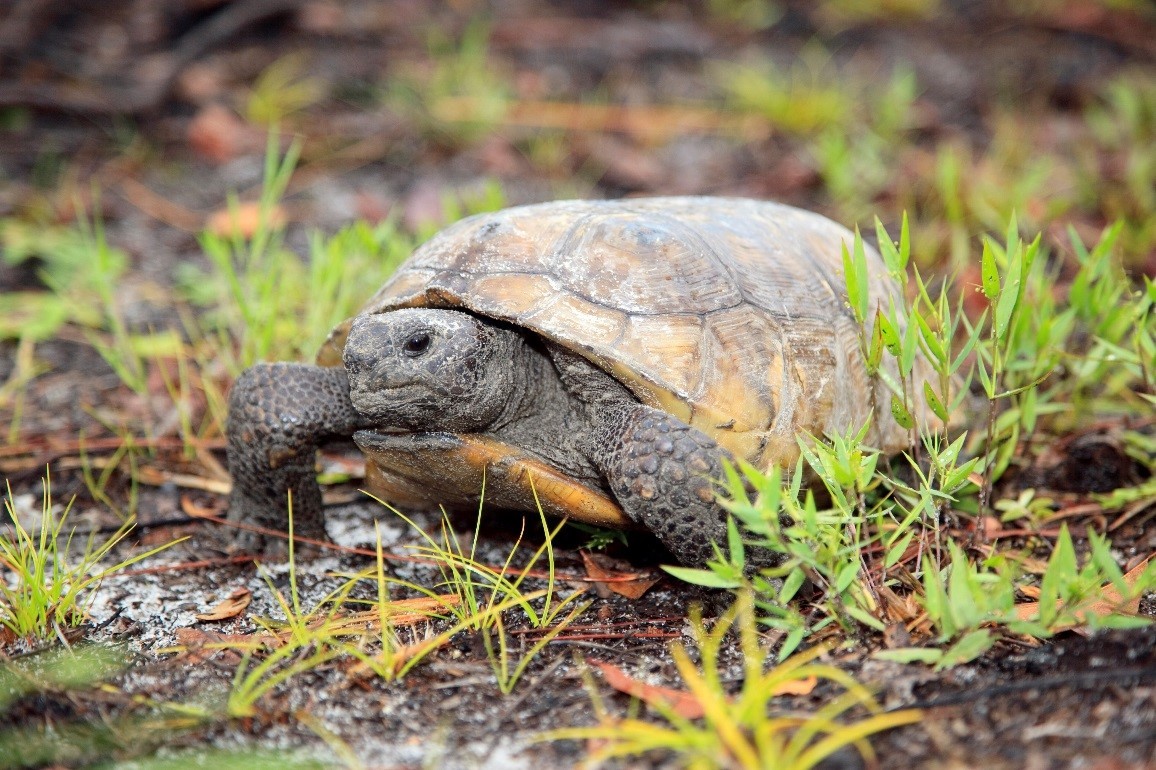
The Department of Defense yesterday announced the winners of the 2019 Secretary of Defense Environmental Awards Winners, including Eglin Air Force Base for Natural Resources Conservation for efforts to save the Gopher Tortoise and restore the habitat and expand the population of the reticulated flatwoods salamander.
Eglin during 2017-2018 relocated 1,030 gopher tortoises to avoid its listing under the Endangered Species Act and potential mission encumbrances. Eglin also conducted 160 prescribed burns across more than 145,000 acres on base, removing 290,000 tons of hazardous fuel biomass, and reducing wildfires caused by mission activities on test areas by 20%. Additionally, efforts to restore the habitat of the reticulated flatwoods salamander at Escribano Point Wildlife Management Area may enable the site to support “one to two orders of magnitude” more of the population than it currently supports.
Eglin is the largest forested military reservation in the U.S. and the largest Air Force installation in the world, encompassing 464,000 acres of land and 123,000 square miles of water test ranges. This extensive area supports essential Defense missions and diverse ecosystems that provide sanctuary to 106 rare, threatened, and endangered plant and animal species. The installation is responsible for the development, acquisition, testing, deployment, and sustainment of all air-delivered conventional weapons for the Air Force. The installation’s total economic impact to the area exceeds $2.75 billion annually, per DoD.
“Strong environmental programs increase training access, improve mission readiness, and provide the capabilities required to prevail in conflict and preserve peace, all of which support DOD’s lines of effort to accomplish National Defense Strategy objectives,” said Ellen Lord, Under Secretary of Defense for Acquisition and Sustainment.
Major accomplishments which led to the recognition include:
• As part of the multi-agency Gopher Tortoise Candidate Conservation Agreement, Eglin AFB is partnering with the U.S. Fish and Wildlife Service, the Florida Fish and Wildlife Conservation Commission, and Texas A&M University to translocate 6,000 tortoises in six years. The installation showed its commitment to the agreement’s goals and objectives in FY18 by translocating 1,030 gopher tortoises displaced by urban development in peninsular Florida to Eglin AFB. The gopher tortoise is a candidate for listing under the Endangered Species Act (ESA), and its presence or potential presence on 23 military installations across the southeast would result in significant operational impacts if the species was indeed listed under the ESA.
• Eglin AFB manages the Air Force’s largest prescribed fire program, and in FY17 and FY18, the installation conducted 160 prescribed burns across more than 145,000 acres on base. These burns removed 290,000 tons of hazardous fuel biomass, reduced wildfires caused by mission activities on test areas by 20%, and decreased wildfire suppression time by over 300 man-hours.
• The installation obtained $530,000 in Readiness and Environmental Protection Integration (REPI) funding to conduct habitat and species management efforts on 3,500 acres on the Escribano Point Wildlife Management Area (EPWMA) for the critically endangered reticulated flatwoods salamander. This was DoD’s first ever REPI project that did not include a DoD land acquisition component. By duplicating decades of habitat management activities at Eglin AFB, EPWMA habitat quality has improved, and the landscape may be able to support one to two orders of magnitude more reticulated flatwoods salamanders than it currently supports. This project will continue for the next five years and will support species recovery efforts that should greatly reduce long-standing training restrictions on the installation.
• Eglin AFB manages DoD’s largest natural resources-based outdoor recreation program. During the achievement period, the installation supported opportunities including hiking on 71 miles and cycling on 36 miles of designated trails, canoeing and kayaking on more than 186 miles of rivers and streams, and camping at 13 designated primitive camp sites. These recreation opportunities promote public awareness and an appreciation of the efforts to preserve Eglin AFB’s natural environment.
• Eglin AFB is a member of the Gulf Coast Plain Ecosystem Partnership which has grown from seven original partners to 15, and from a land base of 840,000 acres to approximately 1.25 million acres since 1996. In FY17 and FY18, the Partnership helped Eglin AFB implement 41 prescribed burns totaling 45,152 acres, which established two 100-acre gopher tortoise relocation pens that now house over 500 tortoises.
Other 2019 winners include:
- Environmental Quality, Industrial Installation: Wisconsin Army National Guard
- Environmental Quality, Overseas Installation: Marine Corps Base Camp Smedley D. Butler, Okinawa, Japan
- Sustainability, Non-Industrial Installation: Marine Corps Air Station Miramar, California
- Sustainability, Individual/Team: East Campus Reclaimed Water Team, Fort Meade, Maryland • Environmental Restoration, Installation: Naval Base Ventura County, California • Cultural Resources Management, Small Installation: Washington Army National Guard
- Cultural Resources Management, Individual/Team: Ms. Rita McCarty, Mississippi Army National Guard
- Environmental Excellence in Weapon System Acquisition, Small Program: Tagnite Technical Working Group, U.S. Army Research Laboratory, Aberdeen Proving Ground, Maryland]
According to the DoD, the Secretary of Defense Environmental Awards were established in 1962 to celebrate Military Service members and civilians for their exceptional commitment to protecting human health and the environment while advancing the military mission.
A diverse panel of 58 volunteer judges with relevant expertise from Federal and state agencies, academia, and the private sector evaluated the 2019 nominees to select one winner for each of the nine categories that cover six subject areas, per DoD.





















































